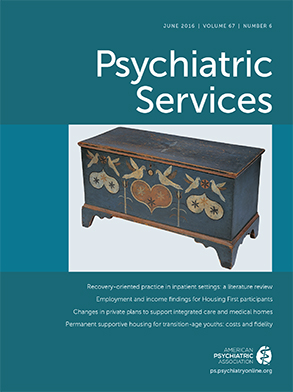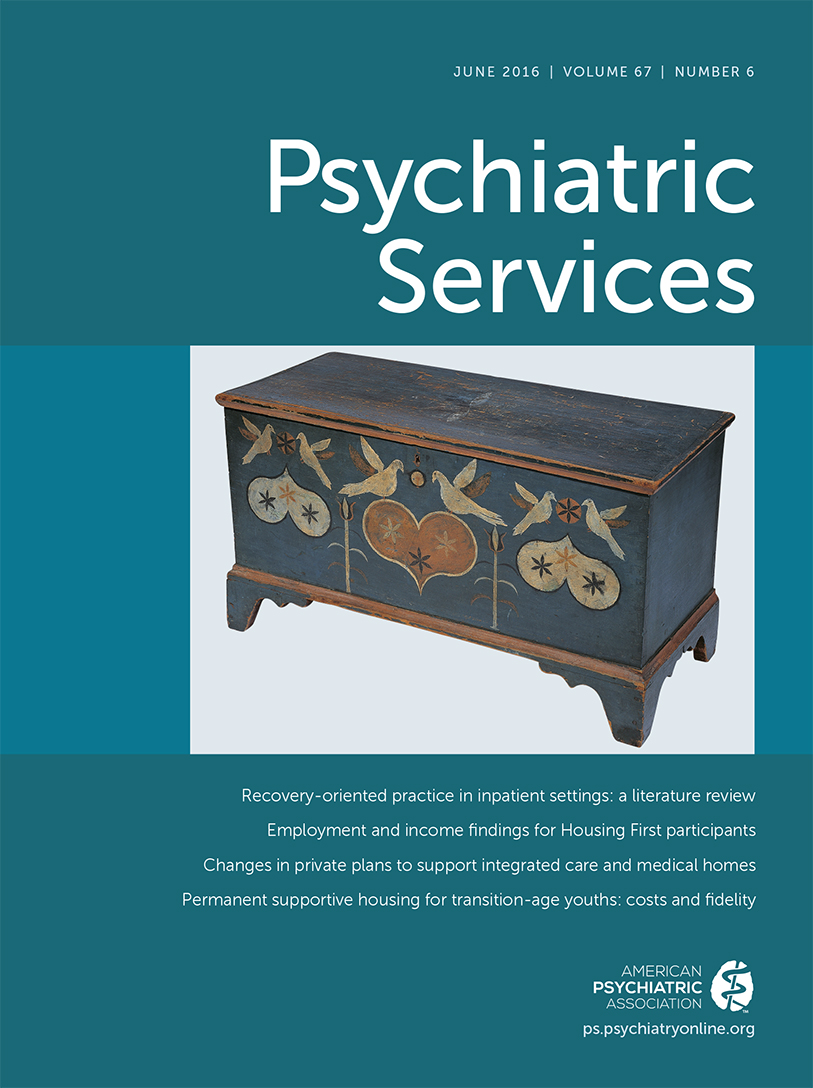Service use.
The study provided gender and age profiles of common diagnoses by ICD-10 code, as well as typical treatment regimens, for more than 2,000 outpatient consultations over a 20-month period. We found that use of outpatient mental health care at the Beira Central Hospital was primarily by individuals under age 36 (61% age ≤35) who were seeking care for severe mental illnesses, namely schizophrenia and schizotypal or delusional disorders, which accounted for over 40% of all outpatient consultations. Schizophrenia was the single most common diagnosis, accounting for almost 30% of all outpatient consultations. [Tables presenting demographic and clinical data are included in an online supplement to this column.] Overall, less than 14% of all outpatient consultations were for new patients. Among visits by patients with common diagnoses, schizophrenia accounted for the lowest proportion of first-visit patients—less than 4% of consultations were for new patients. These findings are concerning because they indicate that few new patients are entering the outpatient care system. Cross-national studies from other settings indicate that schizophrenia does not have differential incidence or prevalence by gender. Therefore, it is encouraging that no significant gender differences were found in service use for schizophrenia in our sample. In addition, overall mental health service use was almost perfectly balanced between genders, an indicator that services may be skewed toward severe illness and away from common mood disorders, because across diverse global primary care settings depression is twice as prevalent among women.
Epilepsy was the second most common outpatient psychiatric diagnosis. Patients with epilepsy were significantly younger than patients in the average consult and more likely to be male (60% of cases). These data suggest that men may have a higher burden of epileptic disorders in central Mozambique; this is not surprising, because studies indicate that men may have a higher incidence of epilepsy in other sub-Saharan African countries (
3). Gender differences may be especially important for neurotic and mood disorders. These conditions were rarely diagnosed in our outpatient sample (only 4.7% and 1.9%, respectively), and patients with these diagnoses were more likely to be female. For example, 87% of patients with a depressive episode, 73% of patients with adjustment disorder, and all patients given a diagnosis of bipolar disorder were female. These findings indicate that females were four times more likely than males to receive a diagnosis of depressive illness. This is surprising because in most settings, the prevalence of major depressive disorder is estimated to be twice as high among women than men (
4). The elevated mean age of those seen for depressive illness (40–45 years) may indicate heterogeneity in diagnoses, care seeking, or prevalence of depression by age—important questions for future studies.
With only five total cases of bipolar disorder diagnosed among 2,071 consultations and the relatively stable population point prevalence of .7%−1% globally (
5), it seems likely that bipolar disorder may be routinely misdiagnosed. This could represent a missed opportunity for suicide prevention, given that individuals with bipolar disorder are estimated to be 60 times more likely than the general population to die from suicide (
6).
As expected, given the cultural climate around psychoactive substance use, males were more likely to be given diagnoses of substance use disorders. A previous population-level study of alcohol consumption in Mozambique found only a twofold higher prevalence of current alcohol drinking among men compared with women (
7). Our study found a nearly ninefold higher prevalence among males, which could result from either underuse of treatment or underdiagnosis among females with substance-related issues, potentially because of strong stigma associated with females’ use of psychoactive substances.
Treatment patterns and quality.
The first-generation antipsychotics trifluoperazine, fluphenazine, decanoate of fluphenazine, haloperidol, and chlorpromazine—all of which are on the national essential medication list (
2)—were the most common treatment regimens for most types of organic disorders, as well as for psychoactive substance use, schizophrenia and delusional disorders, and intellectual disability. Most often, these first-generation antipsychotics were prescribed alongside promethazine—an unusual combination because promethazine is not a first-line treatment for prevention of extrapyramidal side effects in high-income countries nor is it recommended in the WHO Mental Health Gap Action Program (WHO mhGAP).
Evidence-based guidelines from WHO mhGAP state that anticholinergics should not be routinely prescribed to prevent the development of extrapyramidal side effects, should be considered only for short-term use among patients with significant existing side effects, and should not be prescribed for long-term use by pregnant women. Given that a large proportion of patients treated in this setting are women of reproductive age and that promethazine is not first-line treatment for the prevention or treatment of extrapyramidal symptoms, the routine pairing of promethazine or other anticholinergic agents with first-generation antipsychotics should be reviewed. Moreover, antipsychotics and anticholinergics are contraindicated in the treatment of delirium and dementia, with an increased mortality risk, although this was the treatment of choice in our sample. As evidence-based guidelines recommend biperiden for first-line treatment of extrapyramidal side effects, its availability could be prioritized and going forward it could be used in place of promethazine.
The most cost-effective treatment for schizophrenia in lower–middle-income countries (LMICs) includes antipsychotics plus psychosocial interventions, which increase improvement by 15% to 26% compared with no treatment (
8). Similarly, evidence-based recommendations suggest that diazepam is preferable to manage acute alcohol withdrawal and that antipsychotics are not indicated as stand-alone treatment. In the outpatient setting in Mozambique, an increased focus on brief (five to 30 minutes) psychosocial interventions for substance use and schizophrenia with potential follow-up seems warranted and is supported by strong evidence from other settings.
There are many reasons why a treatment regimen not initially indicated in evidence-based guidelines would be prescribed in this setting: clinicians treat patients with complex symptoms that may not always correspond to a single diagnosis on the basis of Western-developed systems; many best-evidence treatments are not consistently (or ever) available in Mozambique or in other similar LMICs; and the reality of available financing, time, and information access to adopt recent evidence-based guidelines is limited in Mozambique and similar settings. For example, use of first-generation antipsychotics by individuals with a primary diagnosis of a substance-related disorder may make sense if these patients have comorbid psychotic symptoms. In regard to the availability of best-evidence treatments, methadone, buprenorphine, acamprosate, naloxone, and disulfiram are all indicated to manage alcohol withdrawal or to reduce relapse, but none are available in Mozambique. Finally, many psychiatric technicians have been practicing since 1996 with few opportunities for formal retraining as new formularies are adopted and evidence-based guidelines change. Going forward, formal evaluations of the psychiatric technician program, including training, retraining, supervision structures, and effectiveness of treatments provided, could drive quality improvements.
Limitations.
This study had limitations. First, our data lacked a gold-standard comparison diagnosis, impeding the determination of whether, for example, men are more likely than women to be given an epilepsy diagnosis or men are actually presenting more often with epilepsy symptoms. Second, the reliability and validity of using the complex ICD-10 classification system in this setting are unknown and could be evaluated. Third, these data are from one hospital in Mozambique and thus are likely not representative of diagnostic and treatment patterns in rural areas or smaller clinics.

